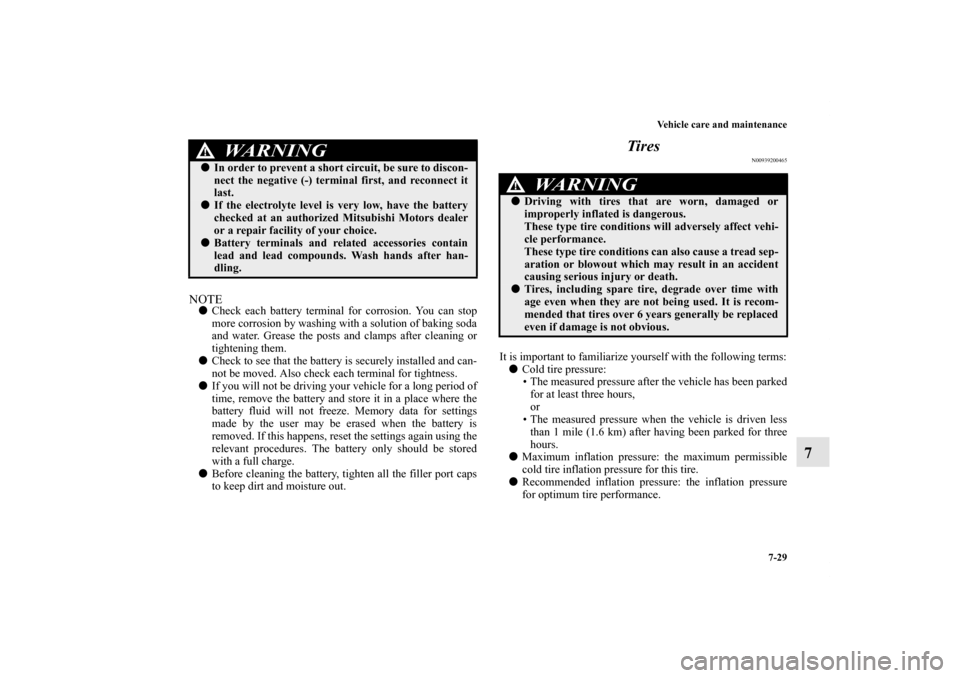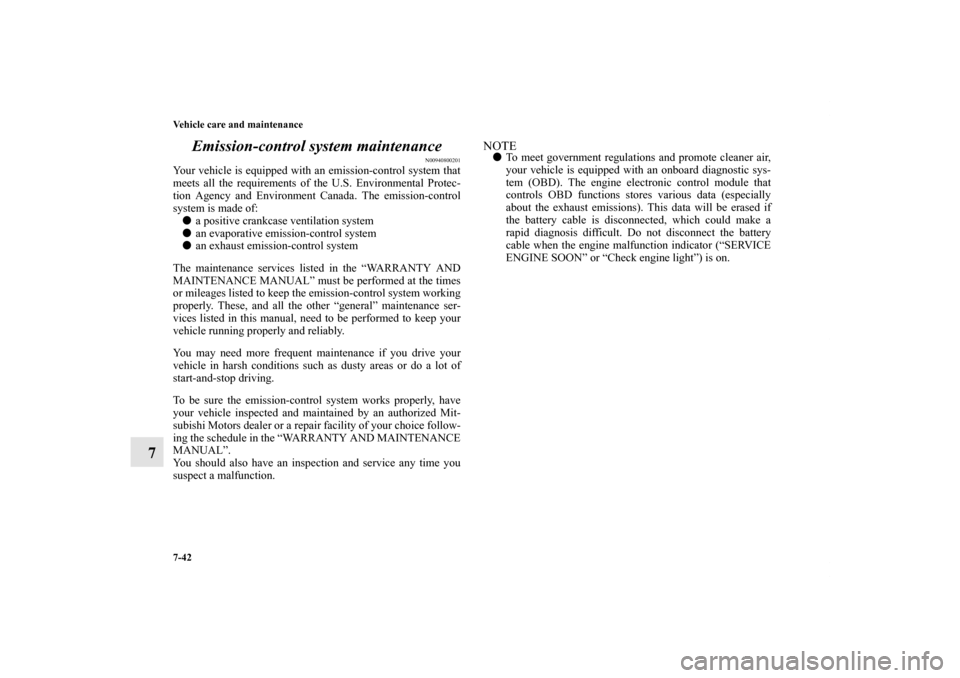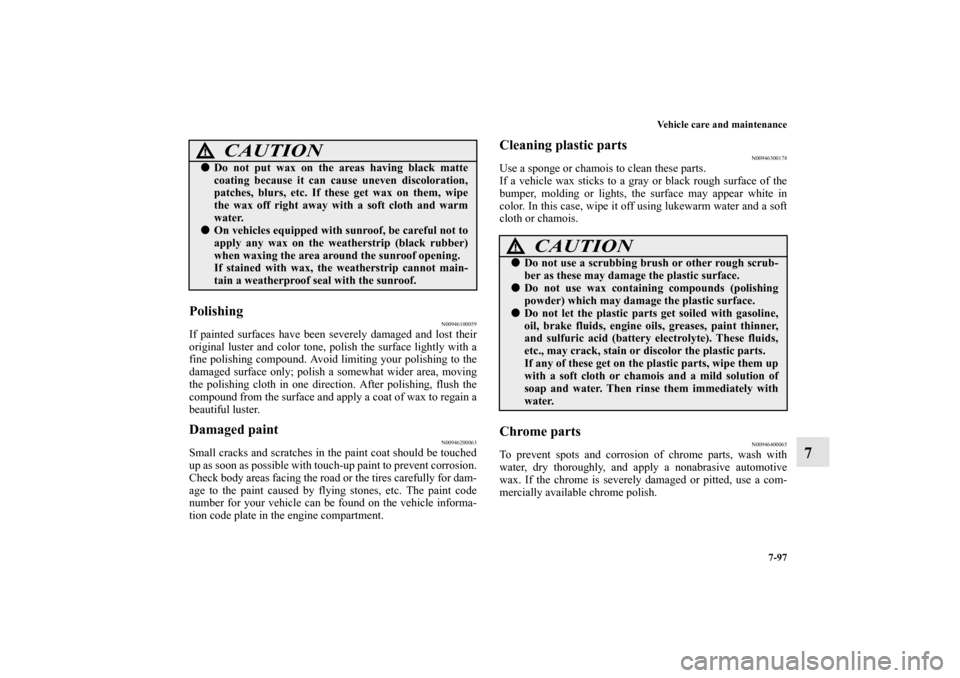Page 608 of 706

Vehicle care and maintenance
7-29
7
NOTE�Check each battery terminal for corrosion. You can stop
more corrosion by washing with a solution of baking soda
and water. Grease the posts and clamps after cleaning or
tightening them.
�Check to see that the battery is securely installed and can-
not be moved. Also check each terminal for tightness.
�If you will not be driving your vehicle for a long period of
time, remove the battery and store it in a place where the
battery fluid will not freeze. Memory data for settings
made by the user may be erased when the battery is
removed. If this happens, reset the settings again using the
relevant procedures. The battery only should be stored
with a full charge.
�Before cleaning the battery, tighten all the filler port caps
to keep dirt and moisture out.
Tires
N00939200465
It is important to familiarize yourself with the following terms:
�Cold tire pressure:
• The measured pressure after the vehicle has been parked
for at least three hours,
or
• The measured pressure when the vehicle is driven less
than 1 mile (1.6 km) after having been parked for three
hours.
�Maximum inflation pressure: the maximum permissible
cold tire inflation pressure for this tire.
�Recommended inflation pressure: the inflation pressure
for optimum tire performance.
�In order to prevent a short circuit, be sure to discon-
nect the negative (-) terminal first, and reconnect it
last.�If the electrolyte level is very low, have the battery
checked at an authorized Mitsubishi Motors dealer
or a repair facility of your choice.�Battery terminals and related accessories contain
lead and lead compounds. Wash hands after han-
dling.
WA R N I N G
!
WA R N I N G
!�Driving with tires that are worn, damaged or
improperly inflated is dangerous.
These type tire conditions will adversely affect vehi-
cle performance.
These type tire conditions can also cause a tread sep-
aration or blowout which may result in an accident
causing serious injury or death.�Tires, including spare tire, degrade over time with
age even when they are not being used. It is recom-
mended that tires over 6 years generally be replaced
even if damage is not obvious.
BK0125300US.book 29 ページ 2010年5月18日 火曜日 午後1時53分
Page 621 of 706

7-42 Vehicle care and maintenance
7Emission-control system maintenance
N00940800201
Your vehicle is equipped with an emission-control system that
meets all the requirements of the U.S. Environmental Protec-
tion Agency and Environment Canada. The emission-control
system is made of:
�a positive crankcase ventilation system
�an evaporative emission-control system
�an exhaust emission-control system
The maintenance services listed in the “WARRANTY AND
MAINTENANCE MANUAL” must be performed at the times
or mileages listed to keep the emission-control system working
properly. These, and all the other “general” maintenance ser-
vices listed in this manual, need to be performed to keep your
vehicle running properly and reliably.
You may need more frequent maintenance if you drive your
vehicle in harsh conditions such as dusty areas or do a lot of
start-and-stop driving.
To be sure the emission-control system works properly, have
your vehicle inspected and maintained by an authorized Mit-
subishi Motors dealer or a repair facility of your choice follow-
ing the schedule in the “WARRANTY AND MAINTENANCE
MANUAL”.
You should also have an inspection and service any time you
suspect a malfunction.
NOTE�To meet government regulations and promote cleaner air,
your vehicle is equipped with an onboard diagnostic sys-
tem (OBD). The engine electronic control module that
controls OBD functions stores various data (especially
about the exhaust emissions). This data will be erased if
the battery cable is disconnected, which could make a
rapid diagnosis difficult. Do not disconnect the battery
cable when the engine malfunction indicator (“SERVICE
ENGINE SOON” or “Check engine light”) is on.
BK0125300US.book 42 ページ 2010年5月18日 火曜日 午後1時53分
Page 676 of 706

Vehicle care and maintenance
7-97
7
Polishing
N00946100059
If painted surfaces have been severely damaged and lost their
original luster and color tone, polish the surface lightly with a
fine polishing compound. Avoid limiting your polishing to the
damaged surface only; polish a somewhat wider area, moving
the polishing cloth in one direction. After polishing, flush the
compound from the surface and apply a coat of wax to regain a
beautiful luster.Damaged paint
N00946200063
Small cracks and scratches in the paint coat should be touched
up as soon as possible with touch-up paint to prevent corrosion.
Check body areas facing the road or the tires carefully for dam-
age to the paint caused by flying stones, etc. The paint code
number for your vehicle can be found on the vehicle informa-
tion code plate in the engine compartment.
Cleaning plastic parts
N00946300178
Use a sponge or chamois to clean these parts.
If a vehicle wax sticks to a gray or black rough surface of the
bumper, molding or lights, the surface may appear white in
color. In this case, wipe it off using lukewarm water and a soft
cloth or chamois. Chrome parts
N00946400065
To prevent spots and corrosion of chrome parts, wash with
water, dry thoroughly, and apply a nonabrasive automotive
wax. If the chrome is severely damaged or pitted, use a com-
mercially available chrome polish.
�Do not put wax on the areas having black matte
coating because it can cause uneven discoloration,
patches, blurs, etc. If these get wax on them, wipe
the wax off right away with a soft cloth and warm
water.�On vehicles equipped with sunroof, be careful not to
apply any wax on the weatherstrip (black rubber)
when waxing the area around the sunroof opening.
If stained with wax, the weatherstrip cannot main-
tain a weatherproof seal with the sunroof.
CAUTION
!
CAUTION
!�Do not use a scrubbing brush or other rough scrub-
ber as these may damage the plastic surface. �Do not use wax containing compounds (polishing
powder) which may damage the plastic surface. �Do not let the plastic parts get soiled with gasoline,
oil, brake fluids, engine oils, greases, paint thinner,
and sulfuric acid (battery electrolyte). These fluids,
etc., may crack, stain or discolor the plastic parts.
If any of these get on the plastic parts, wipe them up
with a soft cloth or chamois and a mild solution of
soap and water. Then rinse them immediately with
water.
BK0125300US.book 97 ページ 2010年5月18日 火曜日 午後1時53分
Page 678 of 706
Vehicle care and maintenance
7-99
7
Engine compartment
N00947000042
Never spray or splash water on the electrical components in the
engine compartment, as this may cause damage.
Do not allow any nearby parts (such as plastic parts) come into
contact with sulphuric acid (battery electrolyte), which may
crack, stain, or discolour them.
If this occurs, wipe the parts with a soft cloth saturated with a
mild detergent and water solution.
Then immediately rinse the affected parts with plenty of water.
BK0125300US.book 99 ページ 2010年5月18日 火曜日 午後1時53分
Page 686 of 706
9
Specifications
Vehicle labeling . . . . . . . . . . . . . . . . . . . . . . . . . . .9- 2
Vehicle dimensions . . . . . . . . . . . . . . . . . . . . . . . .9- 6
Vehicle weights . . . . . . . . . . . . . . . . . . . . . . . . . . .9- 7
Engine specifications . . . . . . . . . . . . . . . . . . . . . . .9- 8
Battery . . . . . . . . . . . . . . . . . . . . . . . . . . . . . . . . . .9- 9
Tires and wheels. . . . . . . . . . . . . . . . . . . . . . . . . . .9- 9
Refill capacities . . . . . . . . . . . . . . . . . . . . . . . . . . .9- 10
BK0125300US.book 1 ページ 2010年5月18日 火曜日 午後1時53分
Page 694 of 706
Specifications
9-9
9 Battery
N01147800182
Battery is a 12 volt type.
Tires and wheels
N01147900675
PCD: Pitch Circle Diameter (installation holes)NOTE�Contact an authorized Mitsubishi Motors dealer for details
on the combination used on your vehicle.
�These tires satisfy vehicle loading conditions described in
this owner’s manual.
75D23L
Tire P205/60R16 91HP215/45R18 89V,
215/45R18 89WWheel
Size16 x 6 1/2JJ,
16 x 6 1/2J18 x 7JJPCD 4.5 in (114.3 mm)Offset 1.81 in (46 mm)
BK0125300US.book 9 ページ 2010年5月18日 火曜日 午後1時53分
Page 698 of 706

Alphabetical index
1
A
Accessory (installation) 1-8
ACD (Active center differential system) 3-131
Active stability control (ASC) 3-144
Air cleaner filter 7-14
Air conditioning
Automatic air conditioning 5-25
,5-35
Important air conditioning operating tips 5-45
Manual air conditioning 5-6
,5-16
Air purifier 5-46
All-wheel drive system 3-129
Aluminum wheels 7-98
Antenna
Roof antenna 5-141
Anti-lock braking system 3-139
Warning light / display 3-140,3-141
Arm rest 2-8
Ashtray 3-277
Assist grip 3-294
Audio
AM/FM electronically tuned radio with CD player 5-46
AM/FM electronically tuned radio with 6 CD autochanger 5-
74
Error codes 5-130
,5-132
Handling of compact discs 5-138
Steering wheel audio remote control switch 5-127
Automatic air conditioning 5-25
,5-35
Auxiliary audio connector (RCA) 5-125Auxiliary video connector (RCA) 5-125
B
Back-up lights
Bulb capacity 7-58
replacement 7-85
Ball joint, steering linkage seals and drive shaft boots 7-45
Battery 7-23
Charging system warning light 3-216
Disconnection and connection 7-27
During cold weather 7-27
Specification 9-9
Bluetooth 2.0 interface 3-243
Bottle holder 3-291
Brake
Anti-lock braking system 3-139
Braking 4-6
Fluid 7-21
,9-10
Hose 7-44
Parking brake 3-75
Parking brake lever stroke 7-40
Pedal 3-135
Pedal free play 7-40
Power brakes 3-135
Service brake 3-135
Break-in recommendations 3-2
Bulb capacity 7-58
BK0125300US.book 1 ページ 2010年5月18日 火曜日 午後1時53分